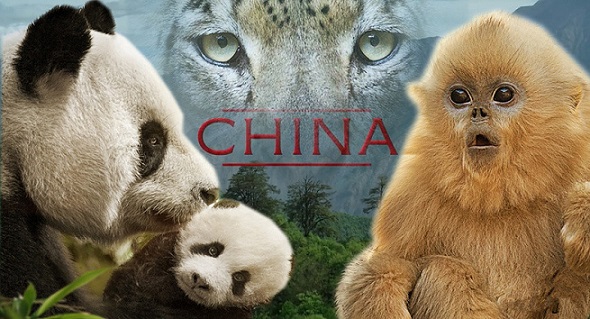There aren’t many films that take a close look at the wildlife of China, but as a country home to some of the most endangered species on the planet, it’s now more important than ever to cast a spotlight on the land’s wondrous wildlife.
Disneynature are doing just that, with their eagerly awaited Born in China set to be released on Friday 21st April. Coinciding with Earth Day (Saturday 22nd April), the film gives an intimate look into the lifestyles of some of the country’s most famed animals, offering hope for the future.
 The stunning documentary principally follows three species in their natural habitats – a giant panda mothering her young cub, a snow leopard struggling to raise two cubs, and a young golden snub-nosed monkey ostracised after the birth of his baby sister.
The stunning documentary principally follows three species in their natural habitats – a giant panda mothering her young cub, a snow leopard struggling to raise two cubs, and a young golden snub-nosed monkey ostracised after the birth of his baby sister.
 All three species are globally recognised as having endangered status due to poaching, habitat loss and the changing climate, with less than 2,000 giant pandas, 4,000 snow leopards, and between just 8,000 and 10,000 golden snub-nosed monkeys in the wild today.
All three species are globally recognised as having endangered status due to poaching, habitat loss and the changing climate, with less than 2,000 giant pandas, 4,000 snow leopards, and between just 8,000 and 10,000 golden snub-nosed monkeys in the wild today.
Armed with a team of highly credited filmmakers, including director Lu Chuan, Born in China is a harrowing tale that heads where very few people have ventured.
The Most Ambitious Film to Date
Journeying to some of the highest peaks, densest forests, and harshest environments in China made the project especially ambitious. The team behind the film painstakingly traversed China’s expansive land to showcase the extraordinary lives of animals we rarely get to look at beyond the cages of zoos or conservation parks.
Actor John Krasinski, who provides the narration for the film, marvelled at the final production, saying in an interview with Entertainment Weekly: “This is the biggest collection of images of snow leopard that’s ever been captured…There are some incredibly brave, incredibly creative and artistic guys who basically just sat on a mountain for months and months and months [to give] incredible insight into a world that you wouldn’t believe is on our planet”.
Just one of those talented men, Wildlife Field Director, Location Producer and Founder of EPM Asia, Steven Ballantyne, spoke of the film’s achievement, saying: “China holds a deep fascination for me, and the more opportunities we create to film there unearths yet more beautiful and complex stories to be told.
 “Filming the snow leopards was an amazing experience, especially due to the complexity of the logistics managed by EPM, and in doing so we met and worked with nomadic families who daily call the mountains home. This in turn led to a wealth of insight into a untold world of survival.”
“Filming the snow leopards was an amazing experience, especially due to the complexity of the logistics managed by EPM, and in doing so we met and worked with nomadic families who daily call the mountains home. This in turn led to a wealth of insight into a untold world of survival.”
Inside the Lives of Three of the Most Endangered Species
The rocky mountaintop terrain of snow leopards in hushed areas of Tibet and Quinghai, their elusive nature and their lusciously camouflaged grey coat has made them near impossible to catch on camera before, with many wildlife experts referring to them as the ‘ghost cat’. Their struggle to survive the frost-biting weather, food scarcity and the threat of poachers is heart-breaking to follow, but the film is prominent in its ambitions to inspire change.
 Similarly, capturing pandas in the wild is largely unheard of, with the various panda sanctuaries taking prominent focus, so the journey into the depths of China’s bamboo forests on the misty mountains of central China is an eye-opening experience. The film really drills home the astonishing fact that their fragmented habitats sit just on the cusp of highly populated cities.
Similarly, capturing pandas in the wild is largely unheard of, with the various panda sanctuaries taking prominent focus, so the journey into the depths of China’s bamboo forests on the misty mountains of central China is an eye-opening experience. The film really drills home the astonishing fact that their fragmented habitats sit just on the cusp of highly populated cities.
 And for the golden snub-nosed monkeys living in the provinces of Sichaun, Gansu, Hubei and Shaanxi, we are given the chance to follow their daily plight and mischievous personalities. Monkeys have long been a holy animal symbol in China, but for these rare primates, their fur has inspired a deadly poaching trade, with the belief in some cultures that it can prevent rheumatism or an inflammation of the joints. Scientists and camera-crew have previously found the high altitudes and cold climates of the species difficult to observe and study.
And for the golden snub-nosed monkeys living in the provinces of Sichaun, Gansu, Hubei and Shaanxi, we are given the chance to follow their daily plight and mischievous personalities. Monkeys have long been a holy animal symbol in China, but for these rare primates, their fur has inspired a deadly poaching trade, with the belief in some cultures that it can prevent rheumatism or an inflammation of the joints. Scientists and camera-crew have previously found the high altitudes and cold climates of the species difficult to observe and study.
Capturing Beauty for the Future
The film transcends the everyday nature documentary, with Disneynature consciously aiming to inspire conservation through this stunning expose.
 The project is in partnership with the WWF, who have been championing conservation since 1961 (alongside their iconic and apt panda logo: a core symbol for endangered species). The Disney Conservation Fund is contributing $0.20 to the WWF per every ticket sold in America during the film’s opening week, and encouraging viewers to support the charity in any way possible. These funds will go towards improving landscape connectivity and integrity across the areas featured in the film, as well as to continue the WWF’s efforts to increase panda populations and enhance conservation stewardship.
The project is in partnership with the WWF, who have been championing conservation since 1961 (alongside their iconic and apt panda logo: a core symbol for endangered species). The Disney Conservation Fund is contributing $0.20 to the WWF per every ticket sold in America during the film’s opening week, and encouraging viewers to support the charity in any way possible. These funds will go towards improving landscape connectivity and integrity across the areas featured in the film, as well as to continue the WWF’s efforts to increase panda populations and enhance conservation stewardship.
Born in China is a breakthrough for Chinese filmmakers, promising, for what seems like the first time (in China), to bring the subject of animal conservation under public scrutiny and promote change for the immediate future.
Image credits: www.nature.disney.com



